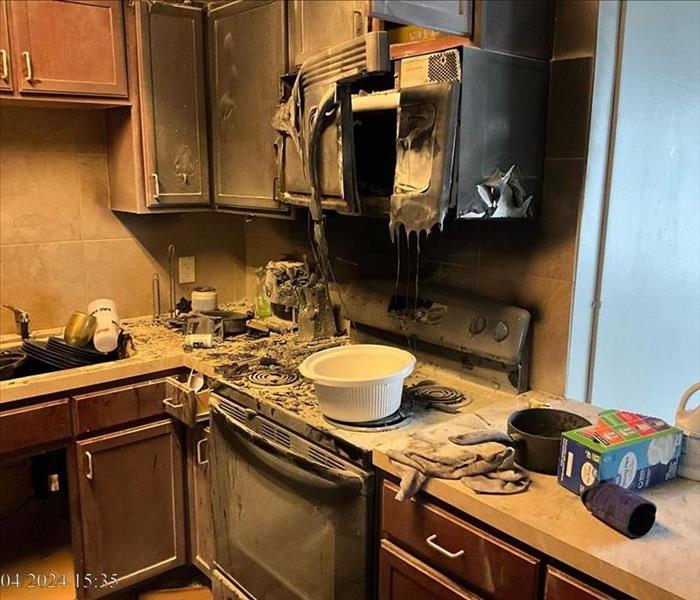How to Identify Fire Damage Beyond the Obvious: Tips on spotting hidden fire damage in a property
7/29/2024 (Permalink)
Experiencing a fire can be devastating, and the aftermath often leaves property owners focused on the visible damage—charred walls, burnt furniture, and scorched belongings. However, fire damage can extend far beyond what the eye can see. Hidden fire damage can pose serious risks to the structural integrity of your property and the health of its occupants. Identifying these less obvious signs is crucial for effective restoration and safety. Here are some tips on spotting hidden fire damage in your property.
1. Inspect Electrical Systems
Fires can cause significant damage to electrical wiring and systems, which might not be immediately visible. Signs to look for include:
- Flickering Lights: If your lights flicker or dim without a clear cause, it might indicate damage to the electrical wiring.
- Burnt Odors: Persistent burnt smells near outlets or switches could signify hidden electrical damage.
- Malfunctioning Appliances: Appliances that suddenly stop working or behave erratically might be connected to fire-damaged wiring.
2. Check for Structural Damage
Fire can weaken the structural elements of a building, even if they appear intact at first glance. Pay close attention to:
- Warped or Discolored Walls and Ceilings: Heat can cause walls and ceilings to warp or discolor. This damage might not be immediately obvious but can indicate deeper issues.
- Sagging Floors or Roofs: Fire can damage the support beams, causing floors and roofs to sag or feel unstable.
- Cracked or Soot-Stained Surfaces: Cracks in the walls or soot stains in unexpected areas can point to hidden fire damage.
3. Examine HVAC Systems
Heating, ventilation, and air conditioning (HVAC) systems can harbor hidden fire damage. Signs to watch for include:
- Smoke Odor from Vents: If you notice a smoke smell coming from your vents, it could mean that soot and smoke have infiltrated the ductwork.
- Reduced Air Quality: Poor indoor air quality, including increased dust or respiratory issues among occupants, can indicate contaminated HVAC systems.
4. Look for Water Damage
Water used to extinguish the fire can cause its own set of problems, often hidden behind walls or under floors. Signs of water damage include:
- Mold Growth: Mold can start growing within 24-48 hours of water exposure. Check for mold in areas that were sprayed with water during firefighting efforts.
- Staining and Bubbling: Water stains, bubbling paint, or peeling wallpaper can indicate water damage beneath the surface.
- Musty Odors: Persistent musty smells can signal hidden water damage and mold growth.
5. Assess Smoke and Soot Damage
Smoke and soot can penetrate deeply into materials, leaving behind damage that isn't immediately visible. To identify hidden smoke and soot damage:
- Smell for Persistent Odors: Lingering smoke smells can indicate that soot has penetrated deep into materials like carpets, drapes, and furniture.
- Test Surfaces: Wipe surfaces with a white cloth to check for soot residue. Even if surfaces appear clean, they might still harbor soot.
- Check Insulation: Smoke can infiltrate insulation materials, which might need to be replaced even if they don't appear damaged.
6. Inspect Plumbing
The heat from a fire can damage plumbing pipes, leading to hidden leaks or other issues. Look for:
- Discolored Water: If your water appears discolored, it could be a sign that fire-damaged pipes are corroding.
- Reduced Water Pressure: Low water pressure might indicate leaks or blockages in the plumbing caused by fire damage.
- Water Stains: Look for water stains on walls, ceilings, and floors that could indicate hidden leaks.
Conclusion
Identifying hidden fire damage is crucial for ensuring the safety and integrity of your property. While some signs might be subtle, paying attention to changes in your home’s appearance, functionality, and odors can help you detect these hidden dangers. For a thorough and professional assessment, consider contacting fire damage restoration experts like SERVPRO of Downtown Kansas City. Our trained technicians have the expertise and equipment to uncover and address hidden fire damage, ensuring your property is fully restored and safe for occupancy.
If you've experienced a fire and need professional assistance, don't hesitate to reach out to SERVPRO of Downtown Kansas City. We are here to help you every step of the way, from initial assessment to complete restoration.



 24/7 Emergency Service
24/7 Emergency Service
